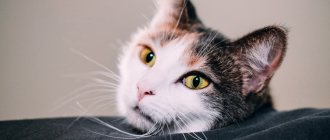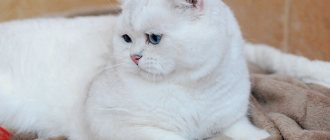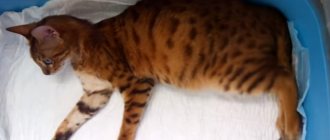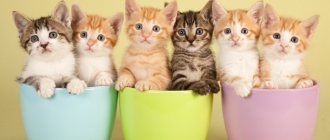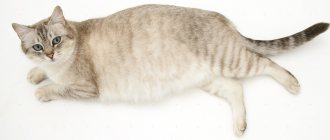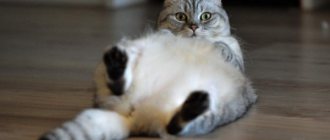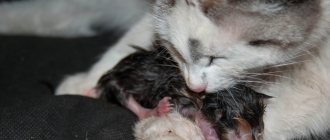On average, a cat reaches puberty between 5 and 12 months of age. In rare cases, a cat may become ready to conceive at 3.5 months. For other females, the maturation process may be delayed until they are 18 months old. If your cat has not started to come into heat after a year and a half, she needs to be seen by a veterinarian.
The following factors influence the age of puberty:
- weight;
- health status;
- conditions of detention;
- season;
- length of daylight hours;
- breed;
- heredity.
Often, in short-haired breeds, maturation occurs earlier - by 6 months, while long-haired breeds become ready for conception only at one year of age.
The cat's readiness to mate is marked by the onset of the first heat. During this period, the animal's behavior changes significantly.
Signs of estrus:
- The cat takes an unusual pose: it presses its front paws to the ground and raises its butt.
- The female cannot find a place for herself, walks all over the house and meows desperately.
- Refusal to eat.
- Insistent attention towards the owner, or vice versa, complete ignoring of him.
Although a cat can become pregnant during her first heat, her body is not yet fully prepared for such stress. Experienced breeders allow a female to be bred only on her second or third heat.
Breeders allow domestic cats to breed until the age of six. In rare cases, breeders also work with older cats for selection purposes. Since pregnancy at this age is associated with serious risks, only animals that are valuable for breeding (for example, an unusual phenotype) are allowed for breeding.
Signs of pregnancy
The first signs of pregnancy in a cat may appear 1-2 weeks after mating. They manifest themselves in changes in behavior, which are caused by changes in hormonal levels. The cat becomes less active. Appetite either increases or decreases. However, these signs may be completely absent in the early stages, or they may indicate not pregnancy, but a disease of the female.
Over time, the cat may begin to vomit. Behavior also changes. The pet either becomes more demanding of attention, or, on the contrary, may begin to avoid the owner. The nipples swell, the skin around them peels off, and fluid is released from them. The stomach becomes denser.
At week 5, the belly becomes significantly larger. After this, it will constantly increase in width. At week 7, when you touch the belly, you can feel the kittens moving.
Optimal age for mating
Puberty in cats occurs between 7 and 9 months of the animal's first year of life. The onset of this period is difficult to miss. The pet exhibits new behavioral traits:
- Slowly walking on half-bent legs;
- Long and persistent meow;
- Constant demand for affection from owners;
- Purring accompanied by rubbing against various objects.
© shutterstock
At the same time, the first estrus appears in females. How quickly this happens, and how regularly it will happen in the future, directly depends on a number of factors, primarily on the breed. This phenomenon is accompanied by increased sexual arousal. By this indicator you can learn about sexual maturity and readiness for reproduction.
With the onset of heat, the cat begins to lick itself frequently and urinates profusely.
You can recognize this by interruptions in appetite. During the period of heat, the cat becomes more affectionate; she rolls and wriggles on the floor for a long time. At any opportune moment, she tries to sneak out into the street . It happens that some individuals during this period show aggression that is unusual for them. It will go away on its own.
The frequency of estrus occurs approximately every three weeks throughout the year. Sexual activity is observed year-round, but heightened desire can be observed in the period from February to March.
However, you should not organize mating before the animal is one year old. Early fertilization threatens the deflection of the spine and the threat of difficult childbirth.
How long does pregnancy last and how does it proceed?
In a cat, pregnancy lasts on average 60 to 65 days. The minimum permissible period for childbirth is 58 days, and the maximum permissible is 71 days.
The duration of pregnancy in a cat is influenced by the following factors:
- Female weight. Thin cats give birth earlier than overweight cats.
- How long does a cat bear fruit? The more kittens, the faster the birth will begin.
- The age of the cat and the number of births. The first pregnancy of a young female often ends in early birth and the birth of weak offspring.
- Breed. Short-haired breeds (Rex, Abyssinian, Russian Blue, Siamese) give birth to kittens 4-5 days earlier than long-haired breeds (Siberian, Neva Norwegian).
- Ordinary yard cats give birth to viable and completely healthy offspring earlier than purebred cats.
Normal pregnancy
How does a cat's pregnancy progress by week?
| Term | Appearance and behavioral changes | How the fetus develops |
| 1 Week | Slight decline in activity, change in appetite | Fertilization of the egg occurs and its attachment to the wall of the uterus |
| from 2 to 3 weeks | Vomiting, toxicosis, decreased appetite, significant decrease in activity | The placenta is formed. The embryo has a visible head and tail |
| 4 week | Nipples turn pink and swell. The cat requires attention and affection from the owner. The abdomen is slightly tight | The formation of internal organs occurs. On ultrasound, you can hear the kittens' heartbeat. The size of each baby reaches 20 mm |
| from 5 to 6 weeks | The abdomen is significantly rounded. When palpated, you can feel the fruits and their movement. The female sleeps and eats a lot | Development of bones, muscles, and nervous system occurs. The body is covered with fur, and claws appear on the paws. The size of babies is 40-60 mm. |
| from 7 to 8 weeks | The abdomen increases greatly in size. The movements of kittens can be seen with the naked eye. The cat goes to the toilet often. Eats small meals often | The fur is finally formed. The x-ray shows the formed bones and spine. Babies begin to develop reflexes |
| Week 9 | The stomach drops towards the hips. The cat begins to look for and arrange a nest. Appetite drops | Kittens reach a size of 13 cm. At 60 days of pregnancy they are completely ready for birth |
False pregnancy
In some cases, after mating, conception does not occur, or the embryos do not attach to the uterus. There is a hormonal imbalance in the cat's body. She begins to behave like a pregnant woman: she sleeps and eats a lot, sets up a place for lambing, her nipples swell. In the early stages, only a specialist can distinguish a real pregnancy from a false one using ultrasound.
A false pregnancy may occur for the following reasons:
- hormonal disbalance;
- heredity (breeds in which this problem most often occurs: Oriental, Rex, Sphynx);
- male sterility;
- psychological stress;
- excess weight;
- the presence of another pregnant cat nearby.
False pregnancy is not very dangerous for the female’s body if it is not a frequent occurrence. Constant hormonal imbalances can lead to diseases of the reproductive system. To reduce the risk of false pregnancy, the following measures should be taken:
- a non-sterile cat must participate in breeding;
- it is necessary to monitor the health of your pet;
- the diet must be balanced;
- You should protect your cat from stress.
Superfetation
Superfetation is a rare phenomenon that sometimes occurs in felines. It consists in the fact that an already pregnant cat may go into heat, resulting in fertilization again. Most often this happens due to hormonal imbalance in the body. In this way, the female will carry kittens conceived several weeks apart. Often the interval between conceptions is 3-6 weeks.
Most often, such pregnancies in cats have a sad outcome. Both litters are born together, which is why the younger, underdeveloped kittens die. Less often, a cat gives birth to older kittens first, and then younger ones a few weeks later. In this case, the owner may be faced with the problem of a cat’s lack of nipples and milk for the entire litter. The owner will have to supplement the babies artificially.
Frozen pregnancy
Sometimes some or all embryos die during fetal development. Only a veterinarian can make an accurate diagnosis after an ultrasound. Indirect signs that indicate a frozen pregnancy: the cat’s belly stops growing, the kittens do not move. If the kittens begin to decompose, intoxication of the body occurs: the body temperature rises, vomiting begins, and refusal to eat. If urgent measures are not taken and the embryos are not removed, the cat will die.
Sometimes, in the case of a frozen pregnancy, the cat immediately miscarries. Also, in some cases, if not all kittens died, the cat gives birth to babies on time. Dead embryos are released along with live kittens.
How to detect a false pregnancy in a cat
The condition of a false pregnancy in a cat is not uncommon. More often, sphinxes, oriental cats, rexes, and Siamese are subject to it, inheriting the vice from their parents.
False pregnancy is a condition in which an unfertilized cat experiences symptoms of pregnancy.
Causes of abnormal behavior:
- mating occurred with a sterile/castrated or sick cat;
- the female’s genitourinary system is disrupted;
- the cat has congenital hormonal disorders, in which a false pregnancy occurs without mating with a male.
False pregnancy is classified as a mental illness in animals.
Signs of false pregnancy:
- lethargy, increased sleep duration, increased anxiety;
- alienation or persistent begging for human affection;
- finding a place to give birth;
- caring for a sock, a soft toy, carrying it in your teeth like a kitten;
- frequent licking;
- slight discharge from the genitals and nipples;
- rounding, thickening of the abdomen;
- enlargement of the mammary glands;
- surges in appetite;
- improper functioning of the gastrointestinal tract;
- slight increase in body temperature.
Ultrasound diagnostics will make it possible to more accurately determine a false pregnancy.
Diagnosis of pregnancy and precursors of childbirth
External symptoms of pregnancy may be false. In the early stages, only a veterinarian can diagnose pregnancy.
The following diagnostic methods exist:
- Blood test for hormones. Until the 30th day of pregnancy, the amount of progesterone in the blood increases significantly. 25 days after ovulation, the level of the hormone relaxin increases in the body.
- Palpation. At day 25 of pregnancy, the doctor can feel the embryos in the cat's abdomen.
- From 3-4 weeks, an ultrasound will help determine pregnancy.
- On the 40th day after mating, the skeletons of the kittens are visible on x-ray.
- A stethoscope can help you listen to the heartbeat of kittens in late pregnancy.
You should not palpate the cat’s belly yourself, as this can harm the female and kittens.
Signs that will help you understand that your cat is going into labor:
- The female eats less than usual or refuses to eat at all.
- The cat is acting restless and rushing around the house.
- The cat constantly licks the area between its hind legs.
- Breathing becomes frequent and shallow, shortness of breath appears.
Sensing the approach of birth, the cat will settle in its nest and will not leave until everything is over.
Determining if a cat is pregnant using ultrasound
Ultrasound of a cat during pregnancy is a common, painless and quick way to determine the period and problems of bearing offspring. The study will allow timely recognition of deteriorating animal health.
Diagnostics helps to see embryos as early as 2 weeks of pregnancy. After 4 weeks, the specialist will determine the exact number of kittens, check the activity of their hearts, and the condition of the cat itself. The movement of the fetuses is recorded, body parts and internal organs of the kittens are recognized. By the end of the 8th week, it is important to determine whether the amount of amniotic fluid is decreasing: the kittens are swallowing liquid. Reducing water levels and the size of the fetuses help the specialist determine the estimated due date for the pet.
Rules and features of caring for a pregnant cat
Pregnancy is a complex process when the female body spends a lot of energy to bear healthy offspring. This is why a pregnant cat needs special care. Your pet needs to be protected from stress and anxiety. If there are small children living in the house, you need to explain to them so that they do not bother or pick up the cat.
A pregnant cat should not jump to great heights. Therefore, it is better to temporarily block access to cabinets, refrigerators and high shelves.
A pregnant cat should not be vaccinated or given anthelmintics. Prevention of infectious and parasitic infections should be taken care of before mating.
A pregnant cat should be played with, as a decrease in activity can lead to obesity. But you can’t overwork your pet. As soon as the cat gets tired, she needs to be given the opportunity to rest.
It is important to isolate the cat from the cat not only before birth, but also after. A cat can become pregnant again even while nursing kittens. In some cases, females are ready to breed again 1.5-2 weeks after giving birth. A second pregnancy will not have the best effect on your pet’s health.
Prematurity and postterm pregnancy
We have found out how long pregnancy in British cats should last under favorable circumstances and proper care. Animals of this breed carry cubs for 9 weeks. But sometimes the due date for such pets can shift due to various reasons. Young cats, for example, often give birth prematurely. Animal owners should not see this as some kind of deviation. In this case, early birth is explained primarily by the fact that the cat’s body is still adjusting to its role as a mother.
Sometimes British women can also carry kittens to term. In any case, veterinarians believe that the optimal delivery time for cats of this breed is 63-66 weeks. If pregnancy is very prolonged, your pet should definitely be shown to a veterinarian. At the clinic, the animal will be provided with all the help it needs.
Shelter and nest for a pregnant cat
The cat should have its own quiet and secluded place where it can rest peacefully. It is better to place the bedding or house in a closed place, protected from drafts and direct sunlight. If the female finds the place secluded and protected enough, she will give birth to kittens there.
2 weeks before lambing, you can place a pre-prepared “nest”. It can serve as a cage, arena, exhibition tent or an ordinary cardboard box. A light cloth or diaper should be placed at the bottom. If the apartment is cold at the time of birth, a warm heating pad should be placed in the nest. They shouldn't be too hot. There must be drinking water near the house.
If the cat chooses another place to give birth, you should not move it.
Preparing for childbirth
1–2 weeks before giving birth, the cat will begin what is called nesting. Usually, from the 7th week of pregnancy, the pet begins to look for a convenient shelf in the closet or other shelter that will become a nest. During this period, it is strictly forbidden to let the cat go for walks, as it may set up a nest outside the house.
Carefully monitor your pet's behavior and do not interfere unless absolutely necessary. If your cat decides to build a nest in your closet, it is wiser to empty the shelf for her than to move the nest to a more convenient place for you. It is necessary to pay attention to the preparation of the nest, if only because the cat can give birth on your bed, clothes or a stack of clean laundry.
Important! During the process of giving birth and feeding the offspring, the cat must be protected from stress as much as possible.
You can avoid negative consequences if you prepare the nest for birth yourself. Stores sell special boxes that are equipped with nests for women in labor. In fact, any sturdy cardboard box with high sides will do.
One wall is cut off, leaving a side that the cat can easily step over. When preparing the nest, it is better to stock up on an extra box, since during birth the cardboard may get wet and tear.
Important! Before making a nest out of a box, make sure that it is not fastened with sharp staples or glued with toxic substances.
Think in advance about how to close the top of the box so that the cat feels private and calm. A few days before giving birth and the onset of contractions, most cats become withdrawn and try to hide. For an expectant mother who will give birth for the first time, it is better to equip several nests at once. Before giving birth, the pet will choose a more optimal and safe (from her point of view) place.
Diet
Much attention should be paid to the pet's diet. A cat that eats commercial food should be switched to special food for pregnant women. If your pet eats natural food, low-fat fermented milk products, liver, and cereals should be included in the diet. Also, after consulting a veterinarian, the female should be given additional vitamins and mineral supplements. Serving sizes should be appropriate for the size, age and breed of the cat. You cannot overfeed the female, otherwise she may develop obesity, which will have a bad effect on pregnancy. Since growing kittens slightly compress the stomach, you should feed your pet more often. In this case, the daily portion of food can be increased by no more than 10%.
When should you contact a veterinarian immediately?
At this time, the cat especially needs a caring attitude from the owner. If she exhibits the following signs, you should call your veterinarian immediately:
- The pet refuses to eat for more than 2 days.
- Fever, above 39 degrees.
- The cat drinks a large amount of fluid and at the same time breathes heavily.
- The female licks herself very often, and dark discharge is observed from the loop. If the discharge is red, you should urgently take it to the clinic.
Attentive attitude to the animal after mating will help to easily determine the presence of pregnancy. Only a specialist will give more accurate information; he will also recommend methods of caring for the cat, tell you how to properly help her prepare for a difficult moment, and give recommendations for helping the animal during childbirth.
Complications during pregnancy
Pregnancy is a complex process associated with great risks to the life and health of the pet. The cat's well-being should be closely monitored throughout pregnancy.
Symptoms that should promptly contact a veterinarian:
- Complete refusal to eat, which lasts more than a day.
- Apathy, weak reaction to stimuli.
- Significant increase or decrease in body temperature.
- Heavy, intermittent breathing.
- Discharge from the loop. The liquid may be pink, red, green or yellow. It may smell unpleasant.
Premature birth and post-term pregnancy are equally dangerous for a cat. If kittens appear earlier than 56 days after conception, the birth is considered premature. Kittens that the cat has carried for at least 50 days can be released. If the babies appeared earlier, they will die.
A pregnancy is considered post-term if the babies have not appeared on the 70th day after conception. Most often, the absence of birth indicates that the kittens have died. In this case, the cat needs urgent surgery, otherwise sepsis may develop. Sometimes cats carry live kittens to term, and the babies are born quite healthy, only later. In any case, only a doctor can find out exactly the cause of a post-term pregnancy using an ultrasound.
An unusual feature of the body: what owners should know about
As already mentioned, during pregnancy, British cats may, among other things, go into heat. At this moment the animal does not ask for a cat. However, mating in this case can still occur. In such a situation, a British woman may develop additional embryos with existing embryos.
In this case, the cat will subsequently give birth to all cubs at the same time. However, some of them, for obvious reasons, will be born prematurely, and their chances of survival will be reduced to zero. Therefore, experienced breeders strongly advise against keeping a pregnant British woman in the same room with a cat.
Artificial termination of pregnancy
There are often no medical indications for induced abortion in cats. Non-viable kittens themselves die in utero. Then they come out naturally or are removed surgically. In most cases, a cat has an abortion at the request of the owner.
There are two types of abortion in cats: medical and surgical.
Medication
- At 3-6 weeks of pregnancy, the cat is given prostaglandins, which cause miscarriage.
- At 6-9 weeks, abortion is performed using glucocorticoids.
Surgical
- Without sterilization: incisions are made in the uterine horns through which the fetuses are removed. The operation is performed on days 15-36 of pregnancy. This is a complex and expensive surgical procedure.
- With sterilization: the uterus and ovaries are removed. The operation is performed before the 7th week of pregnancy.
Often, medical abortions also end in surgical intervention due to the high risk of complications.
Abortion in most cases leads to the loss of reproductive function in the cat. In addition, the animal receives serious stress. Therefore, it is better to sterilize your cat before she becomes pregnant.
The female spends a lot of her body’s resources on pregnancy and childbirth. To ensure that cats have time to recover, experienced breeders breed them no more than once a year. It is worth noting that this process does not add health to the animal, but rather shortens the life of the female and puts her at risk of various complications. That is why it is worth breeding only animals that have value for breeding work. It is better to sterilize outbred cats.
How to detect a frozen pregnancy in a cat
Frozen pregnancy is a common phenomenon in which one or all embryos die in utero. This happens due to hormonal imbalances, infectious diseases, various pathologies of the body, poisoning with chemicals and drugs. In severe cases, miscarriage or death occurs due to infection of the body with cadaveric poison.
Ultrasound can detect non-viable embryos. If a pathology is detected, labor is stimulated. The problem cannot be delayed: a dead fetus is susceptible to decomposition, leading to infection of the cat’s body.
If live kittens are found, the pregnancy is not terminated. Dead fetuses will be released naturally during childbirth.
If a frozen pregnancy recurs, then the question of castration of the female arises.
Pregnancy in cats has some peculiarities that every breeder needs to know. The onset of fertilization and high-quality gestation of offspring is facilitated by puberty and the age of the female, depending on the breed, care, and climate. The optimal age for mating is 1.5 years.
Nutritional Features
Nutritional needs change throughout pregnancy. The first two weeks, when appetite increases slightly, the daily portion is increased by 10%. In this case, the entire volume of food is divided not into 2 meals, as usual, but into 4–5. From 3 to 7 weeks, the amount of feed is doubled from the original. Over the last fortnight, my appetite has decreased slightly as the fruits put pressure on my internal organs.
Pregnant cats have a good appetite
The diet should not contain foods from the human table, especially those containing chemical additives - chips, sausages, smoked meats, including fish. This is harmful to all domestic animals, and their benefits for humans are questionable.
Nomes for feeding cats
Attention! It is important not to exceed recommended servings. This is harmful both for the cat and for the litter formed in the womb. The large body weight and size of kittens can complicate birth. Difficulties also arise with feeding the offspring.
Dry or natural food?
Cat breeders have not yet come to a consensus on which food is better - industrial or natural. But they agree on one thing: if it is ready-made food, then it must be the highest quality available. Switching to a different type of diet will do more harm than good.
Cat breeders never tire of arguing about which food is best.
Dry food familiar to cats is gradually being replaced with analogues for pregnant women. If a special product cannot be found, then simply increase the portion as described above. Experienced breeders recommend special foods for pregnant cats:
Royal Canin Queen
Acana Pacifica
Bozita
Josera Minette for kittens and nursing cats
These brands fall into the holistic and premium categories. They contain a sufficient amount of fat, protein, and amino acids to provide the expectant mother with energy for pregnancy and strengthen her immune system.
Interesting! Feline nutrition experts sometimes recommend feeding kitten foods instead of regular food from the first days of pregnancy and several weeks after birth as an adequate source of protein and energy.
Kitten food is one of the options for complete nutrition for a pregnant or lactating cat.
In addition to the main diet, from time to time you can pamper your cat with natural products - meat, cottage cheese, yogurt. But then this is a delicacy, not the main food.
Many sources on cat nutrition note that it is not worth giving additional vitamins and minerals, since everything necessary is included in the product. Only a veterinarian can determine the possible need for supplements.
Natural nutrition
Breeders pay special attention to the natural nutrition of the cat.
Table 2. Qualitative composition of the diet of a pregnant cat.
| Name | Quantity, % |
| Squirrels | 25 |
| Carbohydrates | 25 |
| Fats | 12 |
| Cellulose | 2-3 |
| Minerals | 6 |
| Water | 29-30 |
Cats usually refuse plant foods. But if you grind it in a blender to a puree and mix it with meat products, then its taste buds can be deceived. You should not cut food into cubes, since only meat pieces will be selected from the plate.
A cat needs the following products:
- dietary meat - chicken, veal, beef (can be raw, but only fresh and high quality);
- sometimes - boiled fish;
- eggs - 2 pcs. in Week;
- low-fat dairy group - cottage cheese, yogurt, sour cream, cream, yogurt;
- cereals - oatmeal, rice, buckwheat;
- jelly, boiled cartilage.
Natural products are necessary for a pregnant cat
For constipation, give the cat beets and increase the amount of vegetable fat. But they are excluded or the dose is reduced after the condition has stabilized.
Attention! It is believed that animals are able to recognize what is harmful or spoiled by smell. This is just a myth. Therefore, it is necessary to ensure that only fresh and high-quality products are supplied to the pregnant woman’s table.
Herbal remedies for pregnant cats
Breeders recommend giving cats an infusion of raspberry leaves. It is prepared from a tablespoon of dry raw materials and a glass of boiling water, left for 15 minutes and filtered. Give a tablespoon 2 times a day from the beginning to the end of pregnancy. This will help bear healthy offspring and simplify the birth process.
In the second half of pregnancy, pre-scalded nettle leaves are added to the drink. These greens promote milk production.
Nettle decoction increases the amount of breast milk
Vitamin supplements for a pregnant cat
It is necessary to ensure the presence in the diet of vitamins A, D, E, B1, B6, B1, as well as calcium, phosphorus, iron, iodine. Taurine, a sulfur-containing amino acid, is extremely important. If the diet is prepared correctly and is not monotonous, the body receives most of these elements from food. But with an unbalanced diet, vitamin preparations with the listed substances are necessary.
The following brands offer vitamin complexes for pregnant cats:
- Beaphar (Top 10 Cat, Salvical, Irish Cal);
- Brewers Yeast 8 in 1;
- Anivital FeliImmun and others.
Vitamin preparations will provide vital elements
Behavior of a cat during childbirth and signs of complications
During the entire birth, the cat must remain in the nest. If the pet is worried and tries to leave, it must be picked up and calmed down. While struggling, the cat may feel the urge to defecate and go to the litter box. You shouldn’t interfere, but watch carefully what happens next.
With this development of events, especially during the first birth, immediately after defecation, a bladder containing the first kitten emerges from the cat’s birth canal. If this happens, there is no need to panic, just pick up the cat and carefully carry it to the nest. The anus and fur under the tail can be gently cleaned using wet wipes.
Postpartum eclampsia is a common, insidious and very dangerous complication for which you need to prepare in advance. In rare cases, a cat experiencing eclampsia may kill or even eat its own kittens. Such a sight is difficult to endure even for an experienced animal owner, but you will have to pull yourself together to save the life of your pet.
All kittens that are born after this must be picked up immediately, mucus removed from the respiratory tract independently and placed in a separate nest with a heating pad. To save the cat, she needs to start taking calcium supplements and carry out maintenance therapy!
Important! Call your veterinarian immediately if your cat tries to strangle your newborn kitten.
In very rare cases, a cat may kill her kittens if they are not viable. For example, with premature birth, premature kittens most often do not survive. However, for a healthy cat that does not suffer from a disorder of the central nervous system, it is more common to refuse to feed the offspring and completely ignore the kittens.


